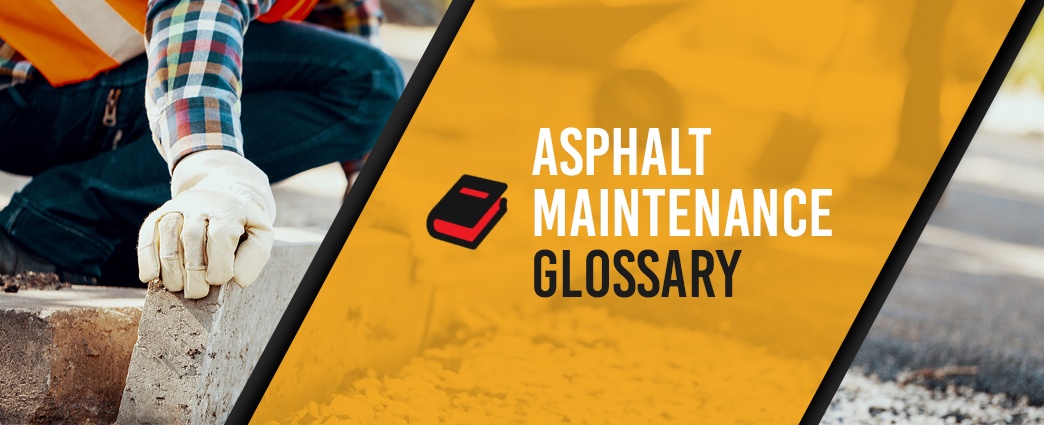
Updated: October 21, 2019
Good property owners know that regular, comprehensive asphalt maintenance is important. Hiring a reliable pavement maintenance contractor that can crack fill, joint seal, tack coat, and sealcoat will take a significant "maintenance worry" off of your list. As a leading pavement maintenance contractor in the Harrisburg and central Pennsylvania region, we pride ourselves on not only completing every project to exceptional standards, but also on educating our customers about the best way to keep their pavement properly maintained throughout the years. This includes an understanding of pavement terminology.
Need to reseal? Contact us now >>Why You Should Understand Asphalt Terminology
Asphalt and parking lot terminology may be a little confusing at first, especially for property owners who might be new to parking lot maintenance. To the untrained eye, any cracking on the pavement may be as indistinguishable as the next. However, a property owner who can tell the difference between block cracking, transverse cracking, reflection cracking, slippage cracking, longitudinal cracking, and fatigue cracking will understand why it's happening and how it needs to be fixed.
Knowing how to define different types of asphalt cracking, along with some basic knowledge about the materials and equipment that contractors use to repair pavement, will allow a property manager to take the proper first steps to maintain their asphalt. Knowing these terms, listed below, can also help a property manager describe the issues they are seeing to a pavement maintenance contractor they are looking to hire.
Asphalt Maintenance Terms
Here are some asphalt maintenance and paving terms, in alphabetical order.
Alligator Cracking
Alligator cracking, also known as fatigue cracking, looks "scaly" like an alligator's skin. Alligator cracking results from load-related deterioration. Some common causes of alligator or fatigue cracking include overloaded vehicles, thin pavement or a weakened subgrade or base course. Light alligator cracking can be overlayed with new asphalt. Severe alligator cracking will need to be removed and replaced with new pavement.
Asphalt Binder
Asphalt binder is also known as asphalt cement or asphalt cement binder. Asphalt binder combined with asphalt aggregate makes a flexible pavement.
Asphalt Overlay
Asphalt overlaying is a resurfacing practice in which a new layer of asphalt is added on top of an existing layer of asphalt. Depending on the condition and needs of the surface, overlaying on the pavement can be a more cost-effective and quick solution for increasing strength without committing to an expensive and time-consuming method of completely removing and repaving the existing asphalt.
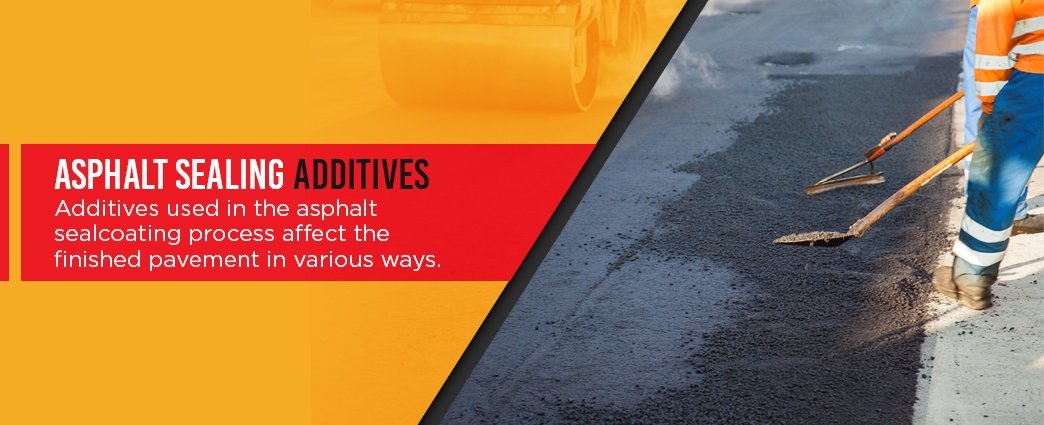
Asphalt Sealing Additives
Additives used in the asphalt sealcoating process affect the finished pavement in various ways. Some additives provide extra strength while others help the pavement resist water, oil, gas or other potentially harmful materials.
Backer Rod
An asphalt crack backer rod is a not a rod at all, but rather, a material that partially fills small asphalt imperfections. These materials are either foam or polyethylene and enhance the effectiveness of the crack sealants.
Base
The base is a catchall term that describes any material used as a strong foundation for the asphalt. Bases vary in their levels of thickness, with a thicker base able to sustain an increased weight. Although a base can use many different types of materials including crushed stone and upcycled pavement, the correct base needs to be applied at the correct level of thickness to ensure that the asphalt in question doesn't fail.
Base Failure
When the base thickness or material can't accommodate the needs of the surface, the base will fail. Weight is a significant influence of failure but groundwater and improper installation can also contribute to base failure.
Berm
A berm refers to a raised surface strip alongside a path or near a body of water. When used in relation to asphalt, it refers to the raised strips of asphalt that act like or replace a curb on either side of the road.
Block Cracking
Block cracking occurs when large sections of interconnecting asphalt cracks create a shape similar to a rectangle. Although these cracks usually cover a large section of pavement, potentially stretching multiple feet, block cracking isn't caused by load issues. When asphalt binder is unable to expand or contract with heat levels, it will shrink, resulting in block cracking.
Bollard
A traffic bollard, or simply a bollard, is a vertical post installed on a paved surface to control and direct both vehicular and pedestrian movement. Bollards can be temporary or permanent. They often block off areas in which vehicles are not permitted or where only authorized vehicles may enter.
Cold Patch
Cold patches are also known as cold mixes or cold asphalt because the asphalt mix does not need to be heated prior to installation. Cold patch material can be used to fill potholes as a temporary fix.
Compaction
Compaction is the process in which each individual layer of asphalt is reduced to a smaller volume to increase density.
Complete Reconstruction
The complete reconstruction of a surface involves removing and replacing all of the asphalt down to the base. This occurs typically when the pavement is at its last stages of life.
Crack Filler
Crack filling is the #1 most cost-effective way to protect asphalt. The crack filler material reinforces the pavement surrounding the cracks and prevents water from penetrating the cracks. Using crack filler can increase the safety, appearance and strength of asphalt substantially.
Crack Sealing
Crack sealing is the process of applying a crack sealant to an area of asphalt.
Call Us for our Resealing Service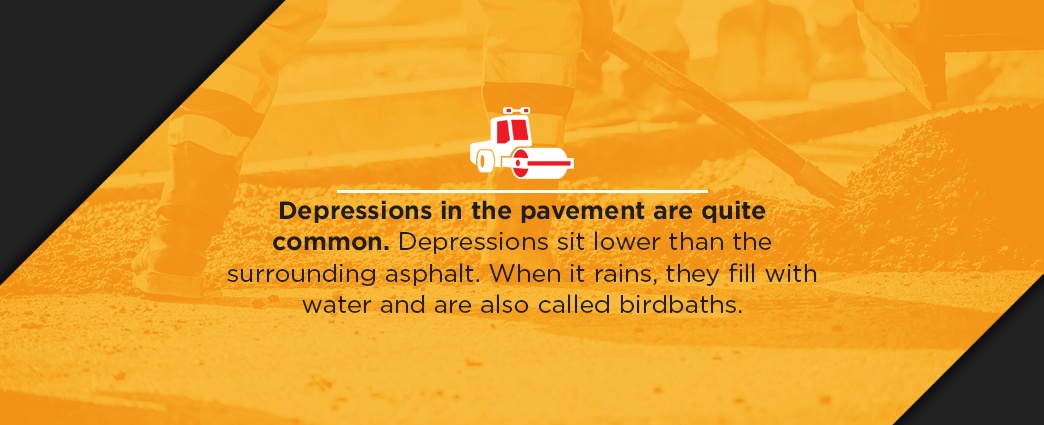
Depressions
Depressions in pavement are quite common. Depressions sit lower than the surrounding asphalt. When it rains, they fill with water and are also called birdbaths. Some light depressions can be fixed via infrared or surfacing patching while severe depressions will likely need to be removed and replaced.
Edge Cracking
Edge cracks are longitudinal cracks that occur within two feet from the edge of the asphalt surface that is next to an unpaved surface. These cracks are signs that the edge of the asphalt lacks support.
Heated Asphalt Distributor
TThe heated asphalt distributor is a versatile truck that can perform a variety of functions. Asphalt distributor trucks are primarily used to spray emulsion materials via a spray bar on the rear of the truck. Using computerized rate control, the truck is able to provide a consistent rate of material application across the surface area.
Heated Hose
A heated hose is the device used to apply a number of different liquid asphalt materials, such as crack sealant.
Infrared Repair
Infrared asphalt repair is a method of surface repair. An infrared machine radiates heat onto the pavement to soften it up. The new asphalt mix is then added and the entire area is compacted.
Longitudinal Cracking
Longitudinal cracking is a form of cracking that is present near the centerline of the paved surface. The cracks can be caused by poor workmanship, shrinkage and reflecting cracks, but do not occur due to load issues.
Oil Spot Primer
An oil spot primer is a product that is applied to patches of oil or grease prior to sealcoating, to ensure that the sealcoat material properly adheres to the pavement. These primers also prevent oils and fuels from bleeding through the seal coat down into the lower layers of a pavement surface.
Patch Paving
Unlike pothole patching, patch paving is a method of pavement repair that removes the full surface layer — and sometimes the base material — then replaces it with new asphalt. It is done to replace severely damaged asphalt, especially surfaces that have endured years of heavy traffic and weather exposure.
Paving Fabrics
Paving fabrics are installed to absorb stress, resist moisture, reduce reflection cracking and increase the life of pavement. These fabrics are made from millable, recyclable materials that are then covered by treatments or overlays.
Reflection Cracking
Reflection cracking is caused not by what happens on the surface of a pavement, but rather, what happens to the underlying asphalt layers. When these layers move due to stress or movement, they create cracks on the surface that mirror that patterns on the base.
Rutting
Rutting is a type of asphalt distortion that occurs on the wheel path of a roadway or parking lot. These vertical or linear surface depressions are caused by problems in the layers of asphalt such as poor compaction, inadequate thickness or inefficient asphalt mixtures.
Call Us for our Resealing Service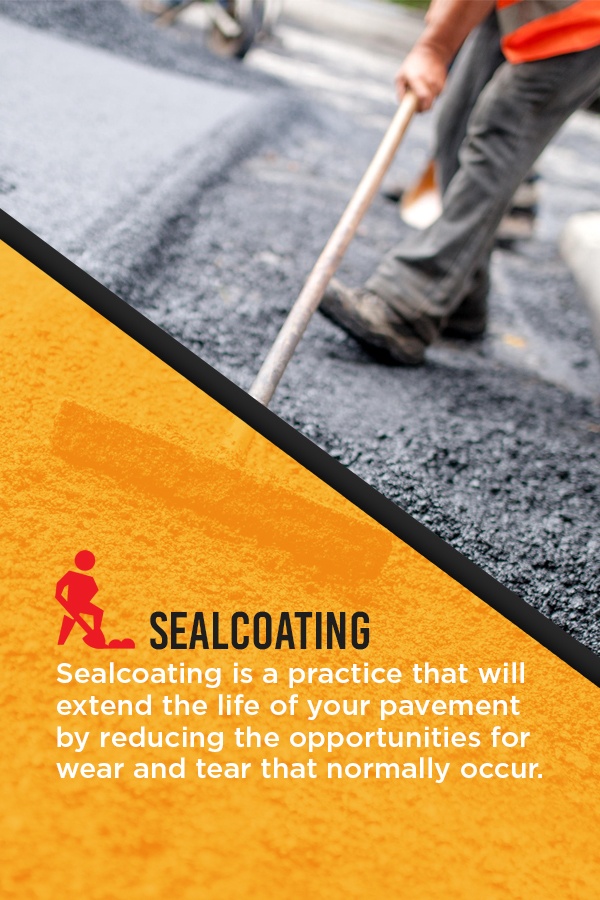
Sealcoating
Sealcoating is a practice that will extend the life of your pavement by reducing the opportunities for wear and tear that normally occur. The sealcoating process involves applying a protective coating material over pavement that protects against oil, water and ultraviolet radiation.
Slippage Cracks
Slippage cracks occur when the bond that binds the surface of the asphalt with the layers beneath it breaks down. Dust, oil and dirt can cause this to happen over time.
Shoving
The ripples that form across a stretch of pavement via horizontal stress is known as shoving.
Spalling
Spalling is a term that refers to damages occurring at the edges of a paved surface. It includes asphalt chips, breakage, cracking and fraying. Spalling is considered a significant problem because it has the potential to spread under increased stress.
Transverse Cracking
Another common form of asphalt cracking, transverse cracking appears perpendicular to the pavement's centerline. Unlike some other forms of cracking, transverse cracks aren't caused by load-bearing problems. Rather, they are caused either by shrinkage of an asphalt layer or from the reflection of an existing asphalt crack.
Upheaval
Upheaval is a type of asphalt depression in which the pavement moves upward via subgrade swelling.
Vibratory Roller
Vibratory rollers are used to compact paving materials. These machines feature two tandem steel drums that vibrate to compact roller-compacted concrete and asphalt mixes. More advanced vibratory rollers are equipped with software that can measure compaction degree and create detailed compaction values for the entire project site.
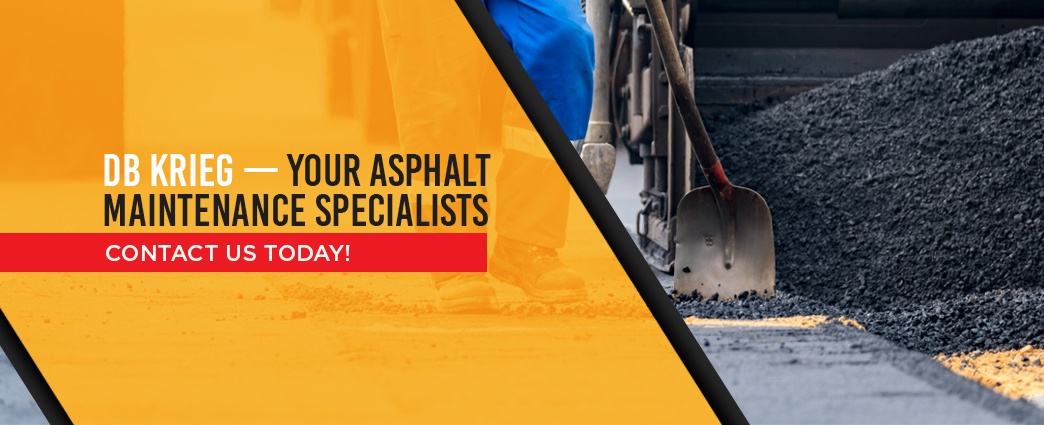
DB Krieg — Your Pavement Maintenance Specialists
There are a lot of asphalt maintenance terms, and while this isn't a fully comprehensive list of all pavement terminology, the terms above are ones you're likely to hear when maintaining your parking lot. Over time, you'll learn how to spot the unique signs of different types of asphalt damage and get them taken care of before your parking lot or roadway inconveniences your customers or damages passing vehicles. By simply crack filling and sealcoating your pavement every 3-4 years, you can double the life of your asphalt and save significant money in the long-run.
Do you need help preserving your asphalt lot? We've been proudly crack filling and sealcoating pavement throughout Central Pennsylvania for nearly a century. Named a Top Sealcoating Contractor for eight consecutive years by Pavement Maintenance & Reconstruction Magazine, DB Krieg is the premier asphalt maintenance company that businesses rely on for the best products and services in the Harrisburg area. From family-owned businesses to PennDOT and the Pennsylvania Turnpike, we can handle any size job.
We're also pleased to offer highway services including tack coating, prime coating, joint sealing, and more. Do you need pavement maintenance or highway safety products for your next job site? Browse our selection of traffic signs, posts, personal protection and safety equipment, drainage pipes, geotextiles, and much more. Learn more about all our high-quality products and contact us today to discover how we can help you preserve and maintain your pavement for years to come.
Contact Daniel B. Krieg For A Quote
Please contact Daniel B. Krieg, Inc. by filling out the form below, or by calling us at one of our locations.
 Back To Top
Back To Top

